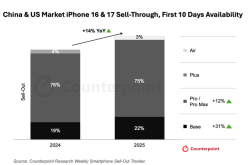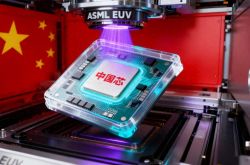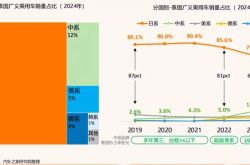Beijing Emerges as "Global Capital of Open Source": Strength and Data Speak Louder than Gimmicks
![]() 05/20 2025
05/20 2025
![]() 788
788
Written by / Keji
Source / Jiedian Caijing
In the vast expanse of human development, each wave of disruptive technology signifies more than a mere iteration; it heralds a reshaping of geopolitics, business landscapes, and even the trajectory of humanity.
The United Kingdom ascended to the throne of the "British Empire" through the steam engine and the Industrial Revolution; the United States cemented its global leadership with the electrification and information technology revolutions. Today, as artificial intelligence (AI) emerges as the core engine of the fourth industrial revolution, the race to control it has intensified, sparking a global frenzy.
Amidst this fervor, Beijing stands out as a unique entity. Unlike Hangzhou's renowned "Six Little Dragons" or Shenzhen's dazzling "Four Giants," Beijing leverages its solid technological foundation, vast industrial scale, and comprehensive ecosystem to steadily march towards becoming the "Global Capital of Open Source."
Let's delve into some data: In 2024, Beijing's AI-related social financing reached 44 billion yuan, accounting for over 40% of the national total, firmly securing the top spot. While other regions focus on breakthroughs in singular technologies, Beijing's AI industry boasts a scale of 350 billion yuan, with the core AI industry growing by over 28% annually.
Furthermore, according to the Hurun China AI Enterprise Top 50 list, Beijing leads with 20 companies, constituting 40% of the list; Shanghai has 9, Shenzhen has 8, and Guangzhou has 4.
These achievements are not the product of short-term hype but the culmination of policies, capital, talent, and ecosystem synergies. Under the banner of "Global Capital of Open Source," Beijing is using data and results to challenge the monopoly of closed-source giants and redefine the global AI landscape.
In the evolution of global informatization, the debate between the open-source approach, which fosters collective wisdom, and the closed-source method, emphasizing systematic precision, has been a hot topic. Prior to the current AI wave, the rivalry between the IOS system and the Android system exemplified this dichotomy.
Apple established its closed-source empire with the IOS system, whereas Android, as a rising star, thrived globally with its open ecosystem. According to the latest data, Android holds a 74% global market share, far surpassing IOS.
Currently, AI development stands at a crossroads, where the battle between open source and closed source transcends a mere technical dispute; it is a strategic game for dominance in AI's future development.
Within the AI open-source camp, China has emerged as a pivotal player, with the open-source DeepSeek gaining worldwide popularity. This year alone, multiple Beijing-based open-source projects have experienced comprehensive growth, yielding remarkable results.
For instance, Zhipu AI's open-source GLM-Z1-Air model achieves performance comparable to the full-fledged DeepSeek-R1 with 32 billion parameters, while boasting an 8x faster generation speed and a reasoning cost of just 1/30. Mianbi Intelligence's open-source end-side model MiniCPM, with 8 billion parameters, offers end-side multimodal capabilities and ranks on Hugging Face's "Most Popular and Downloaded List of 2024." The Beijing Academy of Artificial Intelligence's open-source general vector model BGE is among the most popular globally. Additionally, there's the open-source architecture for humanoid robots, "Tiangong"…
The success of these open-source projects underscores the model's unique advantage in accelerating technological iteration. Through open source, global developers can test various solutions in parallel, swiftly identifying the optimal one. This "collective wisdom" collaborative model starkly contrasts with the closed-door R&D approach of closed-source systems.
Conversely, the closed-source model presents a different scenario. While OpenAI's GPT-4 series once led the trend, its closed ecosystem exacerbated user churn. Security concerns have also become a focal point in the route dispute. The closed-source camp has long defended its strategy with "security and controllability," but frequent data breaches by OpenAI have undermined this argument. The EU's investigation into ChatGPT's data privacy further exposed the "black box" hidden dangers of closed-source systems, which are absent in open-source models. Open-source models allow enterprises to independently review the code, mitigating compliance risks.
Beijing's open-source community is constructing a multi-layered defense system. For example, Zhipu's "Contemplative Model" includes a security adversarial training module, while Mianbi Intelligence's lightweight model supports end-side deployment to reduce data leakage risks. The RISC-V processor core "Xiangshan" series from the Beijing Open Source Chip Research Institute breaks the security black box of the x86/ARM architecture at the hardware level.
Open source is not merely a technological choice but a necessary one for security. The ecological aggregation effect fostered by the open-source community is altering the rules of the game. While the open-source path may seem to forgo short-term commercial interests, it actually aims for a broader strategic goal: gradually dismantling Western technological hegemony by building an open ecosystem. This is the profound significance behind Beijing's aspiration to become the "Global Capital of Open Source."
If Hangzhou's "Six Little Dragons" represent the sharp knives on the AI track, Beijing's AI ecosystem, built upon the foundation of "Global Capital of Open Source," forms an impenetrable shield array.
Beijing's confidence stems from its assembly of top AI scholars nationwide. Universities like Tsinghua and Peking serve as "technological matrices" for large models, while the Beijing Academy of Artificial Intelligence is known as the "Whampoa Military Academy" of the AI world. Beijing hosts approximately 2,400 AI-related enterprises, accounting for about half of the national total, with 132 approved and launched large models, ranking first in the country.
Beijing's AI ecosystem fosters a virtuous cycle of "academic-industrial" talent flow. Unlike the disruptive slogans and declarations in Silicon Valley, Beijing does not excessively pursue short-term bursts in constructing the "Global Capital of Open Source" but systematically builds a full-element support system encompassing talent, data, computing power, and capital.
Open-source competition is not a sprint but a marathon requiring endurance.
In 2023, Beijing adopted the "Implementation Plan for Accelerating the Construction of Beijing as an AI Innovation Hub with Global Influence (2023-2025)," clearly positioning AI as the core engine of "new-quality productivity."
In April 2024, Beijing launched eight major initiatives around the "AI+" strategy, offering rewards of up to 30 million yuan for large models, general intelligent agents, and other projects. Yizhuang invested over 1 billion yuan to establish an "All-Domain AI City," while Haidian invested over 1 billion yuan annually to build an AI industry highland. Notably, the Beijing AI Industry Investment Fund not only directly invests in companies like Zhipu but also drove over 8.6 billion yuan in social capital last year.
These policies are not mere slogans but backed by substantial funding. The dual-wheel drive of "government-guided funds + social capital" has not only ignited the open-source enthusiasm of numerous enterprises but also reconstructed China's AI ecosystem.
Take Kuaishou Keling 2.0 as an example; its text-to-video model outperforms Sora in global evaluations. This achievement is not solely due to Kuaishou's algorithmic innovations but also attributable to the computing power, data, and policy support provided by Beijing. The Keling team has also open-sourced Koala-36M, the highest-quality large-scale video generation dataset available, containing 36 million high-quality video clips, significantly enhancing text-video semantic alignment.
Moreover, the core of Beijing's AI ecosystem lies in "aggregation."
In April 2024, the largest domestic open-source platform Gitee landed in Beijing's Yizhuang, dedicated to establishing an integrated service comprising "computing power plaza + data mall + model supermarket." Simultaneously, the "Industrial AI Empowerment Center" and "Model Ark" community were unveiled, gathering 18 million users, over 2,000 universities, and 35 million code repositories, addressing the issues of insufficient computing power and data scarcity for SMEs. Platforms like the OpenAtom Foundation and OpenSource China attract global developers by fostering international open-source communities.
In Haidian District alone, Beijing boasts over 280,000 market entities, with technology enterprises accounting for 48.9% and nearly 10,000 national high-tech enterprises. This has led to the formation of five 100-billion-yuan industrial clusters in software and information services, artificial intelligence, and technology services. The AI industrial cluster alone houses over 1,300 enterprises, essentially forming a full industrial chain deployment.
Beijing's open-source ecosystem resembles a tropical rainforest, brimming with towering trees and diverse ecological niches, exhibiting a complexity and vitality unattainable by a single technology giant.
Looking back from the 2025 time node, Beijing, committed to becoming the "Global Capital of Open Source," has transformed from a follower to a formidable challenger.
Recently, on May 6, the Beijing Academy of Artificial Intelligence released the large-scale open-source text dataset CCI 4.0 at the GOSIM Global Open Source Innovation Forum held in Paris, France, once again contributing vital open-source resources to the global innovation and development of large models.
Earlier, on April 21, Kunlun Wanwei's SkyReels team officially released and open-sourced SkyReels-V2, the world's first infinite-length movie generation model utilizing the Diffusion-forcing framework. It not only achieves a technical breakthrough but also offers diverse application scenarios, including story generation, image-to-video, camera motion expertise, and multi-agent consistent video generation.
SkyReels-V2 Method Overview
From Zhipu to Zhipu AI, from Kuaishou Keling to Kunlun Wanwei, from BGE to "Xiangshan," numerous Beijing-based institutions and enterprises continue to export technology to the global AI community. Various indicators suggest that China's open-source forces have transitioned from technology recipients to exporters.
Moreover, Beijing's open-source ecosystem is not a fragmented collection of technologies but has developed a full-stack capability spanning from chips to applications. It is precisely based on the profound foundation of the "Capital of Open Source" that the application level can fully flourish, exemplified by Kuaishou Keling AI 2.0's video generation model outperforming Sora with a win-loss ratio of 367%, Shengshu Technology's Vidu Q1 topping both VBench text-to-video rankings, and the "Tiangong" platform of the Beijing Humanoid Robot Innovation Center achieving the world's first example of humanoid running for a fully electric full-size embodied intelligent robot…
Currently, China's technological influence has surpassed expectations, presenting a path of "encircling the cities from the countryside" and gradually penetrating into core business areas.
Accompanying technological advancements, the battle for industry standard-setting rights has commenced. The "Tiancheng Evaluation System" released by the Beijing Academy of Artificial Intelligence aims to establish Chinese standards for large model evaluation, while the MIT open-source license adopted by the GLM series of models is rewriting the business rules of open-source software.
Beijing's open-source enterprises have a clear strategy: by leading evaluation benchmarks and license agreements, they aim to reshape the rules of the game in the global AI technology chain.
Greater attention should be paid to the business model innovation of the open-source route, namely, the "layered open source" strategy, which lays the groundwork for Chinese enterprises' "protracted war." "Layered open source" entails fully open-sourcing the basic model to expand the user base, while generating revenue through the enterprise version of the tool chain and professional support services.
On April 18, the Zhipu Z Fund invested 300 million yuan to support entrepreneurship within the global open-source community, essentially building a business ecosystem through capital ties. This model not only circumvents the profit dilemma of purely open-source projects but also avoids the closed disadvantages of closed-source systems.
In response to the robust development of the open-source model, Sam Altman, CEO of OpenAI, a leading closed-source model, admitted for the first time in February this year that its closed-source strategy "stands on the wrong side of history."
Of course, open source may not entirely replace closed source but offers another possibility for the global development of AI. In this era of rising technological nationalism, Beijing's construction of the "Global Capital of Open Source" is opening up new directions and possibilities for the evolution of human AI.
Facts will inevitably prove that true innovation does not rely on the accumulation of parameters but on the resilience of the ecosystem and an open mindset.
*The featured image is generated by AI








